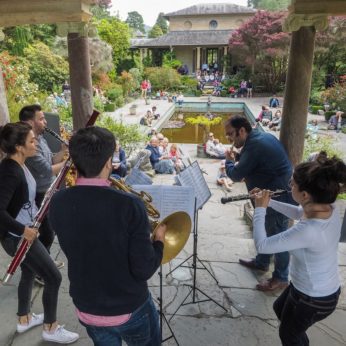Composer: Paul Hindemith (b. 1895 - d. 1963)
Performance date: 07/07/2019
Venue: Bantry Library
Composition Year: 1922
Duration: 00:13:14
Recording Engineer: Ciaran Cullen, RTÉ
Instrumentation: fl, ob, cl, bn, hn
Instrumentation Category:Wind Quintet
Artists:
Azahar Wind Quintet (Frederic Sanchez Muñoz [flute], María Alba Carmona Tobella [oboe], Miguel Ramos Salvadó [clarinet], Antonio Lageres Abeal [horn], María José García Zamora [bassoon]) -
[wind quintet]

Paul Hindemith [1895-1963]
Kleine Kammermusik Op.24/2 [1922]
1. Lustig. Mässig schnell Viertel
2. Walzer. Durchweg sehr leise
3. Ruhig und einfach
4. Schnelle Viertel
5. Sehr lebhaft
In the early Twenties Hindemith created a persona as the enfant terrible of contemporary music by writing both operas and quartets that performers refused to play. The opera Sancta Susanna was the third in a series of provocative one-act operas – it told of the nocturnal sexual fantasies of a novice nun, theatrical dynamite even by today’s standards. It came back to haunt him when the Nazis came to power. His Second Quartet was due to be premiered at the new music festival at Donaueschingen but, when the players backed out, Hindemith put together a new Quartet at short notice that became the famous Amar Quartet with the composer on viola.
The year 1922 was a compositional annus mirabilis for Hindemith – two complete song cycles, a piano Suite, a ballet, a children’s opera, sets of solo and duo sonatas for viola and cello and the wind quintet Kleine Kammermusik. Kleine is an appropriate description, for there is a strong divertimento element about the work. The syncopated rhythms at the beginning are contrasted with a reflective episode in the middle of the first movement, but it only lasts for a few bars before the chirpy pulse returns.
The piccolo replaces the flute in the angular waltz that opens the second movement. This peters out as the bassoon begins a lugubrious theme. This sets the mood for the clarinet’s soulful passage that explores the instrument’s upper register and it is developed into an eloquent oboe melody accompanied by a mock-military rhythm on clarinet. The movement ends as the horn gently imitates the clarinet accompaniment.
The fourth movement, while acting as an introduction to the Finale, is a self-contained fantasy that begins with an angry chord. Each instrument – flute, bassoon, clarinet, oboe and horn – plays a trial flourish rather in the manner of the thematic trials at the beginning of the finale of Beethoven’s 9th Symphony. The finale suddenly imposes itself with a witty little march with sustained chorales on bassoon and horn to support the wild fragments of melody that are played by the other instruments. The work ends with a sequence of close discordant intervals.
Francis Humphrys
Copyright © 2024 West Cork Music. All rights reserved.
Designed and developed by Matrix Internet